What Companies Have Used the Make America Great Again as a Marketing Ploy?
Y'all're paused in the soda aisle at the grocery shop or on your way into work, in search of your morning latte. Coke versus Pepsi, Dunkin' Donuts versus Starbucks–which brand do you choose? For you lot, information technology's a dissever-2d determination shaped by years of addiction and brand marketing. Just for the rival companies, understanding and shaping that conclusion is a daily obsession that involves thousands of employees and costs billions.
Relentless competition is one of the cadre principles of our marketplace economy. We've come a long way since the 1770s, when Adam Smith extolled the importance of contest to the public proficient in The Wealth of Nations. At present CEOs engage in Twitter skirmishes, digital marketers battle for Facebook feed visibility, and intellectual property lawyers wage war via patent filings. The weapons have evolved, even if the competitive imperative remains the same.
For some companies, that imperative takes the class of an intense rivalry. Our September result highlights some of the more than contempo rivalries to emerge, from Vice versus CNN to Xiaomi versus Apple. Hither we examine some of the about influential business rivalries of the late 20th century, along with their lessons for today's corporate leaders.
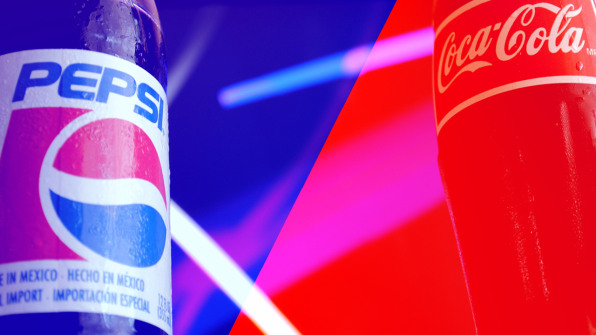
1. Coke vs. Pepsi
Competition, like dearest, can make united states do crazy things. How else to explain Coke'due south disastrous effort to tweak its famous formula and introduce New Coke, a sweeter variation on the classic billion-dollar recipe? During the "Cola Wars" in the 1980s, the Atlanta-based company was losing marketplace share to rival Pepsi and feeling the pressure level to win back consumers swayed by Pepsi's famous gustation exam "experiments," Idiot box advertisements in which blindfolded consumers voted in favor of Pepsi over Coke.
New Coke flopped, and Pepsi sales briefly skyrocketed. But Coke'southward response to the crunch offers a lesson in managing innovation gone wrong. The company apologized to the 400,000 customers who wrote letters of complaint, shipped its old formula to stores every bit "Coca-Cola Classic," and gradually reduced New Coke'due south distribution. By the time the much-maligned new formula disappeared for good, consumers had all but forgotten that it had ever existed.
Today the pecking order for the major soda brands remains remarkably sticky: Coca-Cola on top, and Diet Coke and Pepsi vying for second place. The challenge is that Americans are drinking less soda, with volume dropping past ane.4 billion cases since 2004, and more of nigh everything else–free energy drinks, green juices, flavored waters, artisanal iced teas. In these new categories, Coke has yet to replicate the brand magic that has sustained its sales for decades.
Pepsi, seeing an opportunity, has appear major investments in healthier alternatives to its existing portfolio of products, dominated by empty calories and crave-worthy sweet and salty flavors. The visitor that succeeds in satisfying our wellness concerns–and our taste buds–will rake in the profits.
2. Marvel Comics vs. DC Comics
In 1996, competing comic companies Curiosity and DC (Detective Comics) issued a joint serial in which each publisher's characters engaged in a series of duels. Aquaman harnesses a whale to take down Namor, Elektra sends Catwoman flying off a edifice–with each battle, the intensity seems to drive the publishers farther apart. But Marvel and DC had other ideas: In the final story, characters from both universes join forces–in some cases even merging identities, every bit Batman and Wolverine became Nighttime Claw–in social club to save the 24-hour interval. From rivals to partners: The series ends on a conciliatory note.
Indeed, despite the superhero firepower filling pages, the rivalry between Curiosity and DC has largely been a ceremonious one–Curiosity even refers to DC every bit "Distinguished Competition." Both companies seem to acknowledge the importance of having a worthy competitor, and both take benefited from Hollywood's interest in bringing their characters to the big screen. Back up from corporate owners has facilitated those transfers, with Disney acquiring Marvel in 2009 and DC condign a role of the Fourth dimension Warner conglomerate in 1989.
Now their fates are irrevocably tied to Hollywood, with DC looking alee to the side by side Batman movie, starring Ben Affleck, and Curiosity securing the rights to once again publish Star Wars titles, in advance of the franchise'south new film. Back in the 1990s, Curiosity nearly went bankrupt. Today, it's riding high, with more movies and revenue than its longtime adversary.
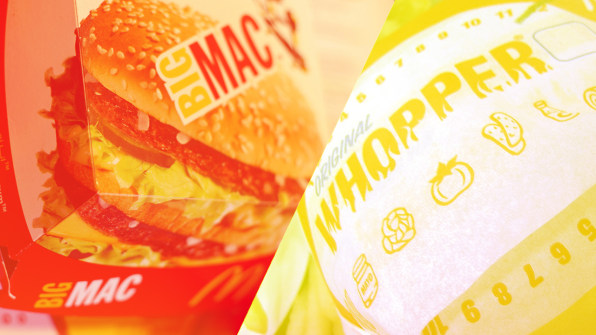
three. McDonald's vs. Burger King
The rivalry between McDonald'southward and Burger King used to come down to 1 thing: the hamburger. Which company'southward burger was cheaper? Better tasting? More convenient? During the '50s and '60s, the golden age of car culture and fast food, the burger chains' menus told a story of moves and counter-moves in their pursuit of consumers' loyalty.
Offset came McDonald's fifteen-cent hamburger. Then came Burger King'south 37-cent Whopper, an try to compete on quality rather than cost. Presently McDonald'southward realized it needed a mammoth burger of its ain, and introduced the Large Mac. More recently, as consumers' tastes have shifted, the companies accept been arguing over which restaurant's craven nuggets contain higher-quality meat.
Indeed, the challenge facing these two rivals used to be simple: Whichever won the burger won the war. Just consumers' stated preference for healthier options (fifty-fifty if they still guild a quarter pounder with cheese) has upended that dynamic and left both companies struggling to define their identities while even so feeding millions of families every 24-hour interval, McDonald'south at its 14,300 U.S. locations and Burger King at its seven,400 in the U.S. and Canada.
From cranberry-orangish muffins to chicken teriyaki sandwiches, both chains accept been experimenting with new ideas in the hopes of winning the trust of health-witting consumers. But the success of burger upstarts similar Shake Shack begs the question: Why aren't they sticking to their roots and finding means to do hamburgers even ameliorate?
4. Ford vs. GM
Motor City, 1912: Startup carmaker General Motors opens its doors, just miles from entrepreneur Henry Ford's stomping grounds. Ford, buoyed by the success of the Model T, was the industry'south leading innovator, bringing cars to the masses past keeping costs depression (in 2015 dollars, the cars sold for approximately $21,700). By 1927, Ford had sold over 15 million Model T'due south, forever changing American culture past introducing young people to the mythic freedom of the open road.
All the while, GM was steadily gaining marketplace share. In 1931, the younger rival unseated Ford as the world's leading automobile manufacturer–and maintained the say-so for the next eight decades. As the ad for one of GM'southward Chevy trucks would say: The company's sales were "like a rock." The company went through a shaky period starting in 2008, when it dropped to number two in the sales rankings and subsequently filed for bankruptcy. But by 2011, afterward shedding brands Saturn, Pontiac, and Hummer–and costing U.S. taxpayers $12 billion in bailout funds–GM was back in fighting class.
Now the race is on to break affordable cars to a new prepare of masses: the rise consumer class in Africa and Asia. Will Ford be able to repeat its history?
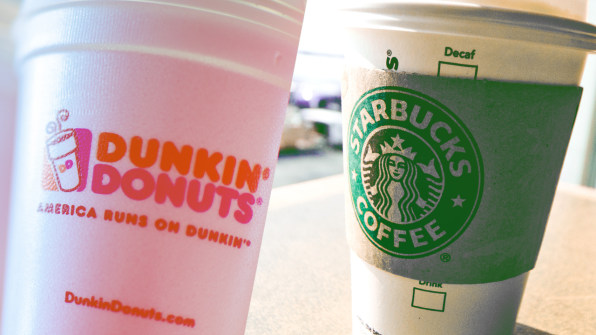
5. Dunkin' Donuts vs. Starbucks
Coffee: For many of u.s., our forenoon caffeine routine is as close as nosotros come to sacred ritual. Peradventure, then, information technology's no surprise that we approach our favorite coffee chains with a near religious fervor–when Dunkin' Donuts opened i of its first California locations, loyal fans started to camp out over the weekend in apprehension of the shop'southward Tuesday opening.
Together, Dunkin' Donuts and Starbucks control 60% of the nation'southward java market–36% Starbucks, 24% Dunkin', co-ordinate to a Harvard report. The ii companies coexisted peacefully during Starbucks's early on growth, with the Boston-based Dunkin' focused on its baked goods and the Seattle-based Starbucks teaching Americans how to say "macchiato."
But in 2003, sensing an opportunity, Dunkin' introduced a line of lattes and cappuccinos, while continuing to emphasize its working-class bona fides. "Y'all society [our drinks] in English, non Fritalian," the company boasted in a 2006 commercial. Contempo marketing campaigns go along to emphasize the make's humour–"I've been craving, I've been peckish–I become hungry when I see that billboard, babe," a Beyoncé stand-in sings in the Dunkin' parody of Queen B's "Drunk in Honey."
That positioning stands in contrast to serious Starbucks, which before this year introduced its #racetogether campaign in the hopes of encouraging customers and baristas to talk about problems of race. Though well-intentioned, the campaign suffered from jeers on social media and a haphazard in-store implementation.
Starbucks had a humor one time upon a time–way back in 2004, it triumphed with a Tv set spot featuring the band Survivor. But marketing aside, Starbucks may well have the last laugh: Last year it earned $9.6 billion in gross profit, versus Dunkin's $613 million, and sales show no signs of slowing down.
6. UPS vs. FedEx
This logistics showdown is all most planes and automobiles. Fedex operates the world'southward largest fleet of all-cargo airplanes, with 700 and counting, and UPS leads in footing vehicles, with a fleet of over 100,000 delivery trucks in its signature chocolate-brown paint. Those fleets are the pes soldiers in the growing east-commerce marketplace, which at present represents 7% of U.S. retail sales. Each twenty-four hour period, the two rivals move 28 meg packages.
For UPS, managing the last mile of package delivery–the notoriously difficult and costly problem of logistics–has become the company's core strength. (FedEx relies on contractors.) A proprietary software program called ORION (On-Road Integrated Optimization and Navigation), which UPS started rolling out in 2008 after nearly a decade of evolution, has helped drivers trim miles from their routes and saved UPS millions in fuel costs and other expenses. ORION will become even more than mission-critical in the years to come, as e-commerce shifts more deliveries to residential customers.
Equally for which is the victor in this competition: UPS is well-positioned and remains ascendant, worth $94 billion to FedEx'southward $51 billion. Just the company that manages to secure a foothold in international markets stands to win big.
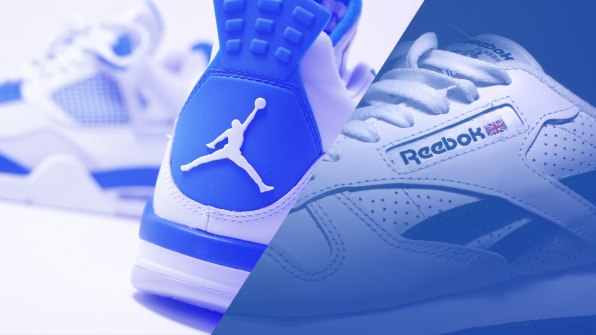
seven. Nike vs. Reebok
In 1984, Nike was struggling. After growing fast for a decade, the sneaker company had striking a speed bump, reporting its first quarterly loss. That summertime, Carl Lewis won four gold medals at the Los Angeles Summer Olympics while wearing a pair of Nike shoes, but fifty-fifty that stroke of skillful fortune failed to boost sales. Reebok's dominance, based on its successful line of women'due south jogging shoes, appeared secure.
Enter Michael Jordan, a promising rookie playing for the Chicago Bulls. Nike took a gamble and convinced Jordan to sign on, despite his admitted preference for Adidas sneakers. The first run of Air Jordans went on auction the adjacent year, retailing for the center-popping $65. Inside ii months, sales hit $70 million. These days, Air Jordans are still the basketball market leader, generating over $2 billion per year.
Reebok, which sold a pop line of sneakers for joggers at the time the Air Jordan debuted, was never able to recover. While Nike went on to add superstars like Andre Agassi and Tiger woods to its portfolio of brand ambassadors, Reebok fizzled. In 2005, Adidas acquired Reebok for $3.8 billion–a fitting cease to a war waged via proxy.
viii. Airbus vs. Boeing
A century ago, on a beach in Florida, the earth's first commercial flight took to the skies, conveying a single passenger who paid the equivalent of nearly $ten,000 in today's dollars. Now, the $160 billion airline industry sells north of iii billion tickets per twelvemonth. China, one of the fastest-growing markets for commercial air travel, is in the midst of edifice 70 new airports and expanding 100 existing ones, according to The Guardian.
That staggering growth has been supported by Airbus and Boeing, the industry's competing aircraft manufacturers. Over the years, they have traded places equally the market leader again and again, along the mode trading jabs over the function of military contracts and government subsidies in the other's success. Secrecy is rampant–even basic information, like the price customers pay for their jetliners, is difficult to obtain. In 2011 a leaked alphabetic character addressed to Rex Abdullah of Saudi Arabia confirmed what observers had long suspected: The companies' sales are a office of statecraft as much equally sales and marketing.
Bottom line: Producing reliable commercial jetliners, on schedule, is an enormously complex undertaking. Both Airbus and Boeing are well-positioned to continue every bit leaders in this duopolistic industry, and do good from exploding travel markets in Asia and Africa.
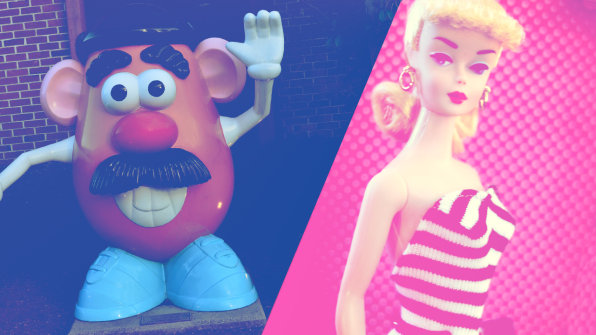
9. Hasbro vs. Mattel
When Mr. Potato Caput and Barbie duke it out, you don't want to be in the room. Those iconic American toys are the creation of Hasbro and Mattel, the country's leading toy manufacturers. They have dominated this $18 billion industry for decades. Mattel rose to prominence in the 1960s with the release of Barbie, only later lost basis to toys similar Hasbro'south Transformers activeness figures. In 1996, Hasbro rebuffed Mattel'south $five.2 billion conquering offer, setting the stage for continued clashes.
In recent years, equally parents accept questioned the gender roles implicit in many traditional toys and children have gravitated toward gaming's glowing screens, the rivals have struggled to remain relevant. In some cases, customers have questioned products that have been in play rooms for years–one xiii-year-old girl, for case, chosen for Hasbro to produce a "boy-friendly" Piece of cake-Bake Oven. At other times, new releases accept reinforced perceptions that the aging companies are out of impact–example in point, Mattel'southward 2010 book about Estimator Engineer Barbie, who needed assist from male programmers in order to save the day.
Mattel shares dipped in July later the visitor reported weak Barbie sales. The challenge for Mattel, as for Hasbro, will be to shift sales toward the more progressive brands in their portfolios. Parents may pass over the latest Barbie, merely in that location's a chance they'll be willing to open up their wallets to buy the latest American Daughter doll.
x. AT&T vs. MCI
Today's text-happy tweens are too young to think MCI, but they owe the visitor a debt of thank you for its role in breaking up AT&T's hold over the telecommunications industry. MCI sued AT&T in 1974, ultimately winning $i.eight billion in damages and precipitating the dismantling of AT&T'south monopoly. In the years that followed, carriers began to compete on price, making long-altitude calls gradually more affordable.
As the industry dynamics became more competitive, innovations in fiber-optic cables and wireless technologies began to change how we communicate and admission information.
In the 1990s, MCI ran into problem after its merger with WorldCom: Company leaders cooked the books to the tune of $11 billion, the second-largest accounting fraud in history. Information technology filed for defalcation in 2002, and sold to Verizon for $seven.vi billion in 2005.
Just MCI'south "creative" arroyo to its remainder sheet extended to its products too, with ideas similar ane-800-COLLECT and a telephone-based music store. The company has been subsumed into its corporate parent, but its legacy of agitating for innovation remains intact.
Source: https://www.fastcompany.com/3048493/the-top-10-business-rivalries-in-history
0 Response to "What Companies Have Used the Make America Great Again as a Marketing Ploy?"
Post a Comment